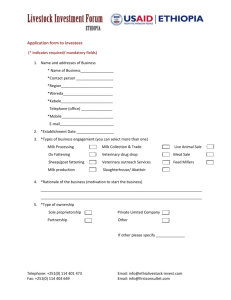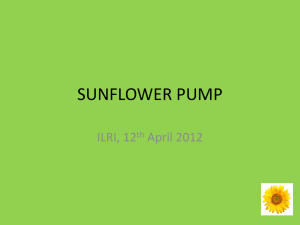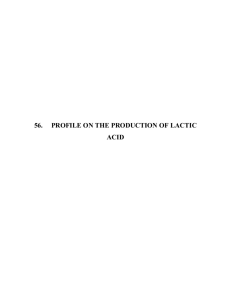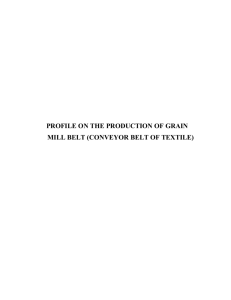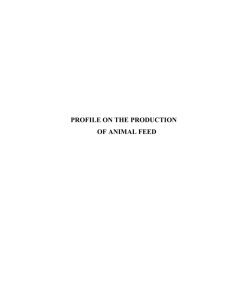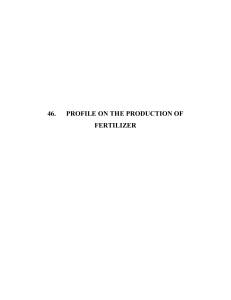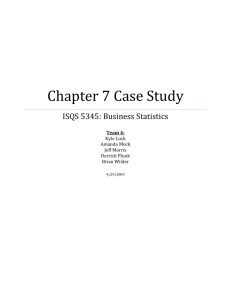Profile on Veterinary Medicine
advertisement
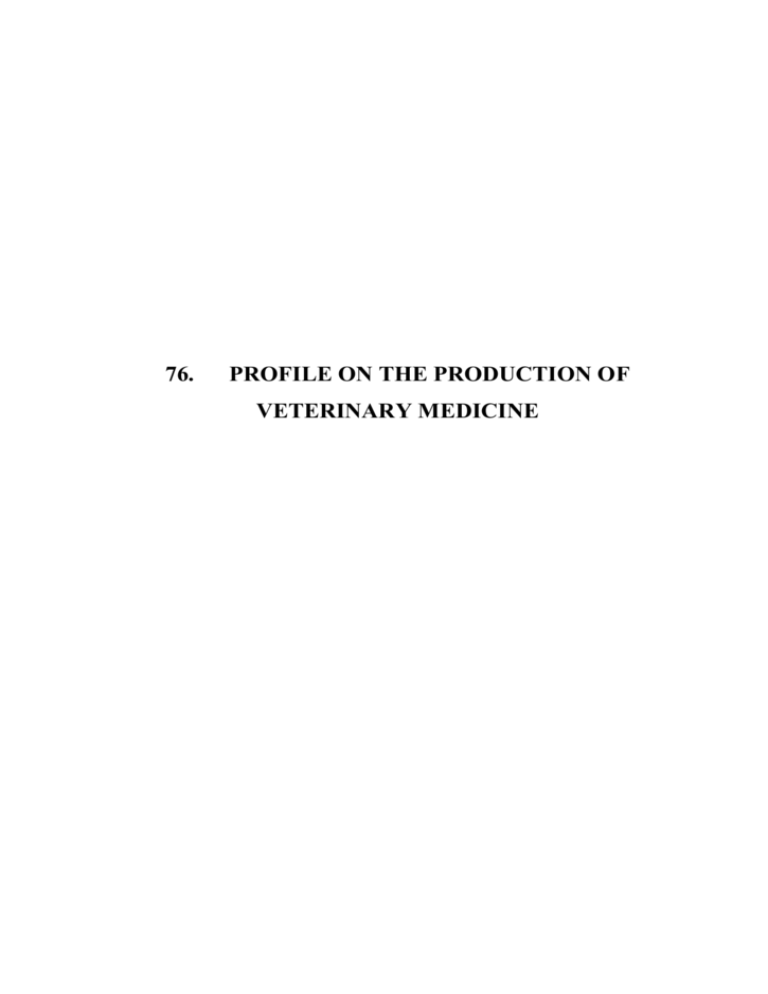
76.
PROFILE ON THE PRODUCTION OF
VETERINARY MEDICINE
76-1
TABLE OF CONTENTS
PAGE
I.
SUMMARY
76-2
II.
PRODUCT DESCRIPTION & APPLICATION
76-3
III.
MARKET STUDY AND PLANT CAPACITY
76-3
A. MARKET STUDY
76-3
B. PLANT CAPACITY & PRODUCTION PROGRAM
76-8
MATERIALS AND INPUTS
76-10
A. RAW & AUXILIARY MATERIALS
76-10
B. UTILITIES
76-10
TECHNOLOGY & ENGINEERING
76-11
A. TECHNOLOGY
76-11
B. ENGINEERING
76-11
HUMAN RESOURCE & TRAINING REQUIREMENT
76-15
A. HUMAN RESOURCE REQUIREMENT
76-15
B. TRAINING REQUIREMENT
76-16
FINANCIAL ANALYSIS
76-16
A. TOTAL INITIAL INVESTMENT COST
76-17
B. PRODUCTION COST
76-18
C. FINANCIAL EVALUATION
76-18
D. ECONOMIC & SOCIAL BENEFITS
76-20
IV.
V.
VI.
VII.
76-2
I.
SUMMARY
This profile envisages the establishment of a plant for the production of veterinary medicine
with an annual capacity of 405 tons of drugs (113tons of antibiotics 258 tons of
anthelimentics and 34 tons of antiprotozoals) and 693.38 thousand liters of acaricides.
Veterinary medicine is used for treatment of sick livestock.
The country`s requirement of veterinary medicines is met through import. The present
(2012) demand for veterinary medicines is estimated to be about 416 tons of solid drugs
(100 tons of antibiotics 282 tons of anthelimentics and 34 tons of antiprotozoals) and 692.38
thousand liters of acaricides. The demand for veterinary medicines is projected to reach
1,131 tons of solid drugs (272 tons of antibiotics 767 tons of anthelimentics and 92 tons of
antiprotozoals) and 1.88 million liters of acaricides by year 2022.
The principal raw materials required are albendazole, berenil, flucanazole (flukazole),
torpidol and strepts penicillin which have to be imported.
The total investment cost of the project including working capital is estimated at Birr 28.38
million. From the total investment cost the highest share (Birr 22.93 million or 80.81%) is
accounted by fixed investment cost followed by pre operation cost (Birr 2.99 million or
10.54%) and initial working capital (Birr 2.45 million or 8.66%). From the total investment
cost Birr 14.18 million or 49.96% is required in foreign currency.
The project is financially viable with an internal rate of return (IRR) of 33.09% and a net
present value (NPV) of Birr 31.90 million, discounted at 10%.
The project can create employment for 66 persons. The establishment of such factory will
have a foreign exchange saving effect to the country by substituting the current imports. The
project will also create forward linkage with the livestock sector and also generates income
for the Government in terms of tax revenue and payroll tax.
76-3
II.
PRODUCT DESCRIPTION AND APPLICATION
The most frequently used veterinary medicines in Ethiopia and their specific application
area are briefly discussed below.
Albendazole:-Albendazole is a benzimidazole anthelmintic produced in syrup (5ml), and
tablets (1.5gm). It is used to control gastrointestinal roundworms, hungworms, tapeworms
and trematodes in cattle, sheep and goats.
Berenil:-Berenil is often chemically referred by the name diminazene aceturate which is an
aromatic dizmidine derivative related to pertamidine, and is an antiprotazoal agent which is
used in the treatment of trupanosomiasis ("Yekola Zinb") and babesisis. In Ethiopia it is
also used to fight against "Gendi". The solution usually contains oxytertacyline. It is
produced in 5 mg / injection.
Flukazol:-Flukazol is a triazole antifungal drug which inhibits tungol cytochrome
dependent enzymes resulting in blocked ergosterol synthesis.
It is active against
aspergillus, blastomayces dermatitidis, etc. In Ethiopia, it is used as anthelminthic, and can
be produced in 200 mg tablets.
Sterepto Pencillin:-It is an antibiotic injection used, for example, against “Gorerssa." In the
envisaged plant strepto pencillin is produced in 2.5 gm per injection.
Torpidol:-Torpidol is an anthelmitic tablet, 1gm/tablet, and widely used to treat horses and
donkeys. Torpidol usually contains fendendazol.
III.
MARKET STUDY AND PLANT CAPACITY
A.
MARKET STUDY
1.
Past Supply and Present Demand
Although Ethiopia has the largest cattle population in Africa, insufficient supply of
veterinary medicines, especially anti-parasite drugs, causes losses in animal production.
76-4
The present population of cattle, sheep, goats and camels, which are the main sources of
demand for veterinary medicine, is depicted in Table 3.1.
Table 3.1
ESTIMATED NUMBER OF CATTLE, SHEEP, GOATS AND CAMELS
(2010)
Animal
Type
Cattle
Sheep
Goat
Camel
Number of
Animals
( Species)
48,202,500
26,143,800
24,039,300
2,293,800
Source: CSA, Statistical Abstract, 2010.
According to the information obtained from the Ministry of Agriculture, the major livestock
diseases in country are shown in Table 3.2.
Table 3.2
MAJOR ANIMAL DISEASES
Animal Type
Cattle
Major Diseases
Pleuropneumonia, food and mouth disease, anthrax, blackleg,
pasteruellosis, gastro- intestinal parasitism, external parasitism
Camel
Trypanosomasis, mange mite, respiratory diseases, anthrax, pasteruellosis,
gastro-intestinal parasitism, wound
Sheep and Goat
Contigious caprine, pleuropneumonia, goat plague, anthrax, pasteurellosis,
foot rot, sheep and goat pox, gastro-intestinal parasitism, mange mite, tick
The most commonly used drugs to treat the above diseases are:
-
Antibiotics
o Oxytetracycline
o Sulfa drugs ( sulfadimidine)
-
Antiprotozoals
o Dimenazene aceturate
76-5
o Anthelimenthics
o Albendazole
-
Acaricdes
o Ethion/Cethion
The average drug requirement and dosage in species is given in Table 3.3.
Table 3.3
DRUG REQUIRMENT AND THERAPEUTIC MARGIN IN SPECIES
Average
Frequency of
treatment
Average Unit dose
Prescribed per kg of
body weight
Average Total
Dose Prescribed
per Animal
Antibiotic
2
5mg
1.25 gm
Anthelimetic
4
7.5 mg
1.875 gm
Antiprotozoal
1
3.5 mg
0.875gm
Acarcides
4
Covering all body area
7 liters (diluted)
Antibiotic
3
5 mg
0.45 gm
Anthelimetic
4
7.5 mg
0.90 gm
Antiprotozoal
1
3.5 mg
0.11gm
Acarcides
4
Covering all body area
4 liters ( diluted)
Antibiotic
3
7 mg
2.1 gm
Anthelimetic
4
7.5 mg
2.25 gm
Antiprotozoal
3
3.5 mg
1.05 gm
Acarcides
4
Covering all body area
7 liter (diluted)
Species/Drug
Cattle
Sheep & Goat
Camel
In order to determine the current country-wide veterinary medicine demand, the drug
requirement and dosage rate in species developed in Table 3.3 was applied on the data
pertaining to number of species (Table 3.1) and the result is shown as Table 3.4.
76-6
Table 3.4
ESTIMATION OF ANNUAL VETERINARY MEDICINE REQUIREMENT
AT COUNTRY LEVEL
Estimated
Number
Species/Drug
Cattle
Antibiotic
Anthelimetic
Antiprotozoal
Acaricides
Sheep & Goat
Antibiotic
Anthelimetic
Antiprotozoal
Acaricides
Camel
Antibiotic
Anthelimetic
Antiprotozoal
Acaricides
Average
Annual Dose
Per Animal (gm)
Total Annual
Requirement
(ton)
48,202,500
2.5
7.5
0.875
28 litre (diluted)*
120.51
361.52
42.18
674,835 liters
50,183,100
0.45
0.9
0.105
16 liters (diluted)
22.58
45.16
5.27
401,465 liters
2,293,800
6.30
9.00
3.15
28 liters (dilute)
14.45
20.64
7.23
64,226 liters
* 1 liter of Acaricide is mixed with 2000 liters of water for dilution
Table 3.4 shows that, assuming a 100% treatment coverage the total requirement of
veterinary medicines would be about 640 tons of drugs (capsules, tablets and vials), and
1.14 million liters of acaricides for deep bathing.
However, since 100% coverage is
unlikely to be attained, based on knowledgeable opinion, the following rates of coverage are
assumed:
Species
Cattle
Treatment coverage
70%
Sheep & Goat
50%
Camel
30%
After adjusting the results in Table 3.4 accordingly, the present demand for veterinary
medicines is estimated to be about 416 tons of drugs (100 tons of antibiotics 282 tons of
Anthelimentics and 34 tons of antiprotozoals) and 692.38 thousand liters of acaricides.
76-7
2.
Demand Projection
The future demand for veterinary medicines depends on the increase in the population of
cattle, sheep, goats and camels as well as the increase in use of these medicines due to
improved awareness of farmers about animal health owing to improved availability of the
medicines and extension services.
According to CSA’s “Statistical Abstract” the livestock population in Ethiopia over the
period 2000--2010 has exhibited an average growth rate of 5.8%. However, as noted
earlier, future demand for veterinary medicines is not only a function of livestock
population growth since a host of factors contribute toward their increased application by
farmers. Hence, in order to take account of these demand stimulating variables, a growth
rate of 8% per annum is deemed to be reasonable. The demand projection executed on this
basis is shown in Table 3.5.
Table 3.5
PROJECTED DEMAND FOR VETERINARY MEDICINES
Year
2013
2014
2015
2016
2017
2018
2019
2020
2021
2022
2023
2024
2025
Antibiotic
(ton)
108
117
126
136
147
159
171
185
200
216
233
252
272
Anthelimetic Antiprotozoal Acaricides
(ton)
(ton)
(lit.)
305
329
355
384
414
447
483
522
564
609
658
710
767
37
40
43
46
50
54
58
63
68
73
79
86
92
747,776
807,598
872,205
941,982
1,017,340
1,098,728
1,186,626
1,281,556
1,384,080
1,494,807
1,614,391
1,743,543
1,883,026
76-8
3.
Pricing and Distribution
Currently, veterinary drugs are sold to farmers at the following prices:
Drug type
Antibiotic
o Oxytetracycline
o Sulfadimine
Antiprotozoa
o Dimenazene
Antihelimetics
o Albendazole 2500 mg
Acaricides
o Ethion/Cethion
Unit
Unit Price (Birr)
Vial (100 cc)
Vial (100 cc)
32
20
Sachet
8
Bolus
4
Litre
170
Since the regional Agricultural Bureaus are selling veterinary medicines to farmers without
any profit margin, on cost recovery basis, the above prices could approximate ex- factory
prices for the envisaged factory.
Purchase of drugs is made in bulk through competitive bidding by Regional Agricultural
Bureaus, on the basis of aggregated requests from animal health units at Woreda level,
which affect the ultimate sales to the farmers.
B.
PLANT CAPACITY AND PRODUCTION PROGRAM
1.
Plant Capacity
Considering the time needed for developing production skill and setting a significant market
share of the products, the capacity of the envisaged plant is summarized in Table 3.6. The
capacity is defined based on the market study, and 300 working days per annum and one
shifts per day.
76-9
Table 3.6
ANNUAL PRODUCTION CAPACITY
Sr. No.
product
1 Antibiotics
2.
Unit of
Measure
Ton
2 Anthelimetic
Ton
3 Antiprotozoal
Ton
4 Acaricides
liter
Qty
113
258
34
692,385
Production Program
Full capacity production may not be achieved just at the beginning of the production phase,
because the local products require enough time to compete with the imported once and
secure reasonable market share. Therefore, in the first and second year of production, the
capacity utilization rate is assumed to be 75% and 90%, respectively. In the third year and
thereafter, full capacity production will be achieved. The production program is indicated
in Table 3.7.
Table 3.7
PRODUCTION PROGRAM (IN '000 PCS)
Sr.
Products
No.
Production Year
1
1.
Antibiotics
2.
3.
2
84.85
101.82
Anthelimetic
193.40
232.08
Antiprotozoal
25.75
30.90
3--10
113
258
34
4.
Acaricides
Production percentage (%)
519,288.6 623,146.30
75
90
692,385
100
76-10
IV.
MATERIAL AND INPUTS
A.
RAW MATERIALS
The major raw materials are albendazole, berenil, flucanazole (flukazole), torpidol and
strepts pencillin. The annual requirement of these chemicals and their cost is indicated in
Table 4.1.
Table 4.1
RAW MATERIAL REQUIREMENT & COST
Sr.
Raw Material
Qty.
Cost ('000 Birr)
No.
FC
1.
Albendazole
2.27
2.
Berenil
1.7
3.
Flucanozole
0.1
4.
Torpidol
2.2
5.
Strepto penicilline
1
6.
Packing materials
Lumsum
B.
Total
1272.20
254.4
1526.60
1595.30
319.1
1914.40
2241.70
448.3
2690.00
516.10
103.2
619.30
1107.80
350.25
221.6
1329.40
230.0
1,576.6
580.25
8,659.95
7,083.35
Grand Total
LC
UTILITIES
Electricity, fuel oil and water are the major utilities of the proposed project. The annual
consumption and its cost is indicated in Table 4.2.
Table 4.2
UTILITY REQUIREMENT & COST
Sr.
No.
1
2
3
Utility
Electricity
Fuel oil
Water
Total
Unit
Qty
kWh 341,982
lt
8,607
3
m
4,418
Cost ('000 Birr)
198.35
172.14
44.18
414.67
76-11
V.
TECHNOLOGY AND ENGINEERING
A.
TECHNOLOGY
1.
Process Description
The major operations of the plant are tablet making, syrup making and filling of capsules.
The manufacturing of tablets consists of the following basic steps: formulation, mixing and
milling, granulation, drying, lubrication, compression and coating.
The syrup making essentially consists of mixing the various ingredients in a jacketed kettle.
The bottles to be used must be separated, washed, sterilized, dried and labeled.
The modern rotary die capsule machine is a self contained unit capable of continuously and
automatically producing finished capsules from a supply of gelatin mass and filling
material.
Accurate filling under pressure and sealing of the capsule wall occur as dual and
coincident operations, each delicately timed against the other.
2.
Environmental Impact Assessment
The disposition of chemicals or waste materials from such industry may affect the
environment up on exposition to direct sunlight, reaction with water and so forth. For this
the envisaged plant will have the proper treatment and waste disposition and incineration
mechanism that at the end of the day the operation ensures secured environment. The cost
of waste treatment system is included in the cost of machinery and equipment.
B.
ENGINEERING
1.
Machinery & Equipment
The total cost of these items is estimated at Birr 16.68 million of which Birr 14.18 million is
in foreign currency. The list of machinery and equipment is indicated in Table 5.1.
76-12
Table 5.1
LIST OF MACHINERY AND EQUIPMENT
Sr.
No.
1
1.1
1.2
1.3
1.4
1.5
1.6
1.7
1.8
1.9
1.10
1.11
1.12
2
2.1
2.2
2.3
2.4
2.5
3
3.1
3.2
3.3
3.4
3.5
3.6
3.7
3.8
3.9
3.10
3.11
4
4.1
4.2
4.3
4.4
4.5
4.6
4.7
2.
Description
Tablet Making Section
Powder mixer (75kg)
Mill unit
Horizontal granulators
Drying oven
Fluid bed dryer (100 kg)
Mechanical lifter
Drum mixer (SS)
Rotary tableting machine
Coating pans (SS)
Canvas polishing pan
Tablet /syrup packing machine
Blister packing machine
Capsule Section
Double cone blender
Blender
Drum mixer (SS)
Capsule filling machine
Capsule counter
Injection Liquid Section
Mixer
Cylindrical tank (SS)
Filler pressed
Industrial stirrer
Emulsifier
Bottle washing machine
Drying oven
Batch printing machine
Label gumming machine
Volumetric liquid filling machine
Capsule sealing machine
Miscellaneous
Boiler
Steam and water piping
Pump, valves and other fittings
Material handling equipments
Weighing scales
Other misc. items
Waste treatment system
Qty
2
1
2
1
1
1
1
2
2
2
2
1
1
1
1
1
1
2
2
2
2
1
1
1
1
1
1
1
set
set
set
set
set
Lump-sum
set
Land, Building and Civil Works
The total area of the plant, including provision for open space, is 2,000 m2, out of which
1,000 m2 is a built-up area. Therefore, the cost of building is estimated at Birr 5 million.
76-13
According to the Federal Legislation on the Lease Holding of Urban Land (Proclamation
No 721/2004) in principle, urban land permit by lease is on auction or negotiation basis,
however, the time and condition of applying the proclamation shall be determined by the
concerned regional or city government depending on the level of development.
The legislation has also set the maximum on lease period and the payment of lease prices.
The lease period ranges from 99 years for education, cultural research health, sport, NGO ,
religious and residential area to 80 years for industry and 70 years for trade while the lease
payment period ranges from 10 years to 60 years based on the towns grade and type of
investment.
Moreover, advance payment of lease based on the type of investment ranges from 5% to
10%.The lease price is payable after the grace period annually. For those that pay the entire
amount of the lease will receive 0.5% discount from the total lease value and those that pay
in installments will be charged interest based on the prevailing interest rate of banks.
Moreover, based on the type of investment, two to seven years grace period shall also be
provided.
However, the Federal Legislation on the Lease Holding of Urban Land apart from setting
the maximum has conferred on regional and city governments the power to issue regulations
on the exact terms based on the development level of each region.
In Addis Ababa, the City’s Land Administration and Development Authority is directly
responsible in dealing with matters concerning land. However, regarding the manufacturing
sector, industrial zone preparation is one of the strategic intervention measures adopted by
the City Administration for the promotion of the sector and all manufacturing projects are
assumed to be located in the developed industrial zones.
Regarding land allocation of industrial zones if the land requirement of the project is below
5000 m2, the land lease request is evaluated and decided upon by the Industrial Zone
Development and Coordination Committee of the City’s Investment Authority. However, if
the land request is above 5,000 m2 the request is evaluated by the City’s Investment
Authority and passed with recommendation to the Land Development and Administration
Authority for decision, while the lease price is the same for both cases.
76-14
Moreover, the Addis Ababa City Administration has recently adopted a new land lease floor
price for plots in the city. The new prices will be used as a benchmark for plots that are
going to be auctioned by the city government or transferred under the new “Urban Lands
Lease Holding Proclamation.”
The new regulation classified the city into three zones. The first Zone is Central Market
District Zone, which is classified in five levels and the floor land lease price ranges from
Birr 1,686 to Birr 894 per m2. The rate for Central Market District Zone will be applicable
in most areas of the city that are considered to be main business areas that entertain high
level of business activities.
The second zone, Transitional Zone, will also have five levels and the floor land lease price
ranges from Birr 1,035 to Birr 555 per m2 .This zone includes places that are surrounding
the city and are occupied by mainly residential units and industries.
The last and the third zone, Expansion Zone, is classified into four levels and covers areas
that are considered to be in the outskirts of the city, where the city is expected to expand in
the future. The floor land lease price in the Expansion Zone ranges from Birr 355 to Birr
191 per m2 (see Table 5.2).
Table 5.2
NEW LAND LEASE FLOOR PRICE FOR PLOTS IN ADDIS ABABA
Zone
Central Market
District
Transitional zone
Expansion zone
Level
1st
2nd
3rd
4th
5th
1st
2nd
3rd
4th
5th
1st
2nd
3rd
4th
Floor
Price/m2
1686
1535
1323
1085
894
1035
935
809
685
555
355
299
217
191
76-15
Accordingly, in order to estimate the land lease cost of the project profiles it is assumed that
all new manufacturing projects will be located in industrial zones located in expansion
zones. Therefore, for the profile a land lease rate of Birr 266 per m2 which is equivalent to
the average floor price of plots located in expansion zone is adopted.
On the other hand, some of the investment incentives arranged by the Addis Ababa City
Administration on lease payment for industrial projects are granting longer grace period and
extending the lease payment period. The criterions are creation of job opportunity, foreign
exchange saving, investment capital and land utilization tendency etc. Accordingly, Table
5.3 shows incentives for lease payment.
Table 5.3
INCENTIVES FOR LEASE PAYMENT OF INDUSTRIAL PROJECTS
Scored Point
Above 75%
From 50 - 75%
From 25 - 49%
Grace
Period
5 Years
5 Years
4 Years
Payment
Completion
Period
30 Years
28 Years
25 Years
Down
Payment
10%
10%
10%
For the purpose of this project profile, the average i.e. five years grace period, 28 years
payment completion period and 10% down payment is used. The land lease period for
industry is 60 years.
Accordingly, the total land lease cost at a rate of Birr 266 per m2 is estimated at Birr
532,000 of which 10% or Birr 53,200 will be paid in advance. The remaining Birr 478,800
will be paid in equal installments with in 28 years i.e. Birr 17,100 annually.
VI.
HUMAN RESOURCE AND TRAINING REQUIREMENT
A.
HUMAN RESOURCE REQUIREMENT
The project will create job opportunities for a total of 66 persons. Annual cost of labor is
estimated at Birr 1,253,040. The list of human resource and labor cost is indicated in Table
6.1.
76-16
Table 6.1
HUMAN RESOURCE REQUIREMENT & COST
Sr.
No.
Manpower
Req.
No.
Monthly Salary
(Birr)
1
2
3
4
General manger
Office Secretary
Administration & Finance
Sales officers
1
2
1
2
5,500
2,000
3,500
2,000
66,000
48,000
42,000
48,000
5
6
7
8
9
10
11
12
Production & tech. head
Accountant
Typist
Production
Supervisor/foremen
Operators
Assistance operators
Laborers
General service
1
1
1
3
22
12
14
6
4,000
2,000
1800
2,400
1,400
1,000
800
800
48,000
24,000
21,600
86,400
369,600
144,000
134,400
57,600
27,200
1,089,600
163,440
Sub-Total
66
Benefits (15% BS)
Total
B.
Annual
Salary (Birr)
1,253,040
TRAINING REQUIREMENT
Training of manpower may take place during plant erection and commissioning by the
experts of machinery supplier. This may cost about Birr 150,000.
VII.
FINANCIAL ANALYSIS
The financial analysis of the veterinary drug project is based on the data presented in the
previous chapters and the following assumptions:Construction period
Source of finance
Tax holidays
Bank interest
Discount cash flow
Accounts receivable
Raw material imported
Work in progress
Finished products
Cash in hand
Accounts payable
Repair and maintenance
1 year
30 % equity & 70% equity
5 years
10%
10%
30 days
120 days
1 day
30 days
5 days
30 days
5% of machinery cost
76-17
A.
TOTAL INITIAL INVESTMENT COST
The total investment cost of the project including working capital is estimated at Birr 28.38
million (See Table 7.1). From the total investment cost the highest share (Birr 22.93 million
or 80.81%) is accounted by fixed investment cost followed by pre operation cost (Birr 2.99
million or 10.54%) and initial working capital (Birr 2.45 million or 8.66%). From the total
investment cost Birr 14.18 million or 49.96% is required in foreign currency.
Table 7.1
INITIAL INVESTMENT COST ( ‘000 Birr)
Sr.
No.
No1
Cost Items
Land Lease
1.2
Building and civil work
1.3
Machinery and equipment
1.4
Vehicles
1.5
Office furniture and equipment
Sub- total
Total
%
Cost
Cost
Cost
Share
53.20
53.20
0.19
5,000.00
5,000.00
17.62
16,680.00
58.77
900.00
900.00
3.17
300.00
300.00
1.06
22,933.20
80.81
1,134.00
1,134.00
4.00
1,856.69
1,856.69
6.54
2,990.69
2,990.69
10.54
2,456.88
2,456.88
8.66
28,380.77
100
2,500.00
8,753.20
14,180.00
14,180.00
Pre operating cost *
2.1
Pre operating cost
2.2
Interest during construction
Sub-total
3
Foreign
Fixed investment
1.1
2
Local
Working capital
Grand Total
14,200.77
14,180.00
* N.B Pre operating cost include project implementation cost such as installation, startup,
commissioning, project engineering, project management etc and capitalized interest
during construction.
** The total working capital required at full capacity operation is Birr 3.05 million.
However, only the initial working capital of Birr 2.45 million during the first year of
production is assumed to be funded through external sources. During the remaining
years the working capital requirement will be financed by funds to be generated
internally (for detail working capital requirement see Appendix 7.A.1).
76-18
B.
PRODUCTION COST
The annual production cost at full operation capacity is estimated at Birr 17.97 million (see
Table 7.2). The cost of raw material account for 48.19% of the production cost. The other
major components of the production cost are depreciation, financial cost and labor, which
account for 22.11%, 9.94% and 6.06%, respectively. The remaining 13.70% is the share of
utility, repair and maintenance, labor overhead and administration cost. For detail
production cost see Appendix 7.A.2.
Table 7.2
ANNUAL PRODUCTION COST AT FULL CAPACITY (YEAR THREE)
Items
48.19
2.31
4.64
1,089.60
163.44
300.00
750.00
6.06
0.91
1.67
4.17
Total Operating Costs
Depreciation
Cost of Finance
12,211.66
3,972.80
1,787.06
67.95
22.11
9.94
Total Production Cost
17,971.52
100
Labor direct
Labor overheads
Administration Costs
Land lease cost
Cost of marketing and distribution
1.
%
(in 000 Birr)
8,659.95
414.67
834.00
Raw Material and Inputs
Utilities
Maintenance and repair
C.
Cost
FINANCIAL EVALUATION
Profitability
Based on the projected profit and loss statement, the project will generate a profit through
out its operation life. Annual net profit after tax ranges from Birr 3.57 million to Birr 7.34
million during the life of the project. Moreover, at the end of the project life the
accumulated net cash flow amounts to Birr 66.61 million. For profit and loss statement and
cash flow projection see Appendix 7.A.3 and 7.A.4, respectively.
76-19
2.
Ratios
In financial analysis financial ratios and efficiency ratios are used as an index or yardstick
for evaluating the financial position of a firm. It is also an indicator for the strength and
weakness of the firm or a project. Using the year-end balance sheet figures and other
relevant data, the most important ratios such as return on sales which is computed by
dividing net income by revenue, return on assets (operating income divided by assets),
return on equity (net profit divided by equity) and return on total investment (net profit plus
interest divided by total investment) has been carried out over the period of the project life
and all the results are found to be satisfactory.
3.
Break-even Analysis
The break-even analysis establishes a relationship between operation costs and revenues. It
indicates the level at which costs and revenue are in equilibrium. To this end, the breakeven point for capacity utilization and sales value estimated by using income statement
projection are computed as followed.
Break-Even Sales Value
=
Fixed Cost + Financial Cost
= Birr 9,434,630
Variable Margin ratio (%)
Break -Even Capacity utilization
= Break- even Sales Value X 100 = 41%
Sales revenue
4.
Payback Period
The pay- back period, also called pay – off period is defined as the period required for
recovering the original investment outlay through the accumulated net cash flows earned by
the project. Accordingly, based on the projected cash flow it is estimated that the project’s
initial investment will be fully recovered within 3 years.
5.
Internal Rate of Return
The internal rate of return (IRR) is the annualized effective compounded return rate that can
be earned on the invested capital, i.e., the yield on the investment. Put another way, the
internal rate of return for an investment is the discount rate that makes the net present value
76-20
of the investment's income stream total to zero. It is an indicator of the efficiency or quality
of an investment. A project is a good investment proposition if its IRR is greater than the
rate of return that could be earned by alternate investments or putting the money in a bank
account. Accordingly, the IRR of this project is computed to be 33.09% indicating the
viability of the project.
6. Net Present Value
Net present value (NPV) is defined as the total present (discounted) value of a time series of
cash flows. NPV aggregates cash flows that occur during different periods of time during
the life of a project in to a common measuring unit i.e. present value.
It is a standard
method for using the time value of money to appraise long-term projects. NPV is an
indicator of how much value an investment or project adds to the capital invested. In
principle, a project is accepted if the NPV is non-negative. Accordingly, the net present
value of the project at 10% discount rate is found to be Birr 31.90 million which is
acceptable. For detail discounted cash flow see Appendix 7.A.5.
D.
ECONOMIC AND SOCIAL BENEFITS
The project can create employment for 66 persons. The project will generate Birr 14.91
million in terms of tax revenue. The establishment of such factory will have a foreign
exchange saving effect to the country by substituting the current imports. The project will
also create forward linkage with the livestock sector and also generates income for the
Government in terms of payroll tax.
76-21
Appendix 7.A
FINANCIAL ANALYSES SUPPORTING TABLES
76-22
Appendix 7.A.1
NET WORKING CAPITAL ( in 000 Birr)
Items
Total inventory
Year 2
Year 3
Year 5
Year 6
Year 7
Year 8
Year 9
Year 10
Year 11
1,731.99 1,948.49 2,164.99 2,164.99 2,164.99 2,164.99 2,164.99 2,164.99 2,164.99 2,164.99
Accounts receivable
826.61
922.12
Cash-in-hand
26.52
29.84
CURRENT ASSETS
Year 4
1,017.64 1,017.64 1,019.06 1,019.06 1,019.06 1,019.06 1,019.06 1,019.06
33.15
33.15
33.39
33.39
33.39
33.39
33.39
33.39
2,585.12 2,900.45 3,215.78 3,215.78 3,217.44 3,217.44 3,217.44 3,217.44 3,217.44 3,217.44
Accounts payable
128.24
144.27
160.30
160.30
160.30
160.30
160.30
160.30
160.30
160.30
CURRENT
LIABILITIES
128.24
144.27
160.30
160.30
160.30
160.30
160.30
160.30
160.30
160.30
TOTAL WORKING
CAPITAL
2,456.88 2,756.18 3,055.48 3,055.48 3,057.14 3,057.14 3,057.14 3,057.14 3,057.14 3,057.14
76-23
Appendix 7.A.2
PRODUCTION COST ( in 000 Birr)
Year
2
Year
3
Year
4
Year
5
Year
6
Year
7
Year
8
Year
9
Year
10
Year
11
6,928
7,794
8,660
8,660
8,660
8,660
8,660
8,660
8,660
8,660
Utilities
332
373
415
415
415
415
415
415
415
415
Maintenance and repair
667
751
834
834
834
834
834
834
834
834
Labour direct
872
981
1,090
1,090
1,090
1,090
1,090
1,090
1,090
1,090
Labour overheads
131
147
163
163
163
163
163
163
163
163
Administration Costs
240
270
300
300
300
300
300
300
300
300
0
0
0
0
17
17
17
17
17
17
750
750
750
750
750
750
750
750
750
750
12,229
12,229
Item
Raw Material and Inputs
Land lease cost
Cost of marketing
and distribution
Total Operating Costs
9,919
11,065 12,212 12,212 12,229 12,229 12,229 12,229
Depreciation
3,973
3,973
3,973
3,973
3,973
230
230
230
230
230
0
2,042
1,787
1,532
1,276
1,021
766
511
255
0
12,714
12,459
Cost of Finance
Total Production Cost
13,892 17,081 17,972 17,716 17,478 13,480 13,225 12,969
76-24
Appendix 7.A.3
INCOME STATEMENT ( in 000 Birr)
Item
Year
2
Year
3
Year
4
Year
5
Year
6
Year
7
Year
8
Year
9
Year
10
Year
11
Sales revenue
18,360 20,655 22,950 22,950 22,950 22,950 22,950 22,950
22,950
22,950
Less variable costs
9,169
10,315 11,462 11,462 11,462 11,462 11,462 11,462
11,462
11,462
VARIABLE MARGIN
9,191
10,340 11,488 11,488 11,488 11,488 11,488 11,488
11,488
11,488
in % of sales revenue
50.06
50.06
50.06
50.06
50.06
50.06
50.06
50.06
50.06
50.06
Less fixed costs
4,723
4,723
4,723
4,723
4,740
997
997
997
997
997
OPERATIONAL MARGIN
4,468
5,617
6,766
6,766
6,748
10,491 10,491 10,491
10,491
10,491
in % of sales revenue
24.33
27.19
29.48
29.48
29.40
45.71
45.71
45.71
45.71
45.71
2,042
1,787
1,532
1,276
1,021
766
511
255
0
Financial costs
GROSS PROFIT
4,468
3,574
4,978
5,234
5,472
9,470
9,725
9,981
10,236
10,491
in % of sales revenue
24.33
17.31
21.69
22.81
23.84
41.26
42.38
43.49
44.60
45.71
0
0
0
0
0
2,841
2,918
2,994
3,071
3,147
NET PROFIT
4,468
3,574
4,978
5,234
5,472
6,629
6,808
6,986
7,165
7,344
in % of sales revenue
24.33
17.31
21.69
22.81
23.84
28.88
29.66
30.44
31.22
32.00
Income (corporate) tax
76-25
Appendix 7.A.4
CASH FLOW FOR FINANCIAL MANAGEMENT ( in 000 Birr)
Year
1
Year
2
Year
3
Year
4
Year
5
Year
6
Year
7
Year
8
Year
9
Item
TOTAL CASH
INFLOW
24,067 22,802 20,671 22,966 22,950 22,950 22,950 22,950 22,950
Inflow funds
24,067
4,442
16
16
0
0
0
0
0
18,360 20,655 22,950 22,950 22,950 22,950 22,950 22,950
Year
10
Year
11
Scrap
22,950
22,950
7,967
0
0
0
22,950
22,950
0
0
0
7,967
18,108
15,376
0
Inflow operation
0
Other income
TOTAL CASH
OUTFLOW
0
24,067 14,361 15,976 16,867 16,296 16,060 18,644 18,465 18,286
Increase in fixed assets
24,067
0
0
0
0
0
0
0
0
0
0
0
Increase in current assets
0
2,585
315
315
0
2
0
0
0
0
0
0
Operating costs
0
9,169
11,479
11,479
0
Marketing and
Distribution cost
0
750
750
750
750
750
750
750
750
750
750
0
Income tax
Financial costs
Loan repayment
0
0
0
0
1,857
0
0
2,042
2,553
0
1,787
2,553
0
1,532
2,553
0
1,276
2,553
2,841
1,021
2,553
2,918
766
2,553
2,994
511
2,553
3,071
255
2,553
3,147
0
0
0
0
0
SURPLUS (DEFICIT)
0
8,441
4,695
6,099
6,654
6,890
4,306
4,485
4,664
4,842
7,574
7,967
CUMULATIVE CASH
BALANCE
0
8,441
13,136 19,235 25,888 32,778 37,085 41,569 46,233
51,075
58,649
66,616
0
0
0
0
0
0
0
0
10,315 11,462 11,462 11,479 11,479 11,479 11,479
76-26
Appendix 7.A.5
DISCOUNTED CASH FLOW ( in 000 Birr)
Item
Year
1
Year
2
Year
3
Year
4
Year 5
Year
6
Year 7
Year
8
Year 9
Year
10
Year
11
Scrap
TOTAL CASH INFLOW
0
18,360 20,655 22,950 22,950 22,950 22,950 22,950 22,950
22,950
22,950
7,967
Inflow operation
0
18,360 20,655 22,950 22,950 22,950 22,950 22,950 22,950
22,950
22,950
0
Other income
0
0
0
7,967
15,300
15,376
0
0
0
0
0
0
0
0
0
TOTAL CASH OUTFLOW
26,524
Increase in fixed assets
24,067
0
0
0
0
0
0
0
0
0
0
0
Increase in net working capital
2,457
299
299
0
2
0
0
0
0
0
0
0
Operating costs
0
9,169
11,479
11,479
0
Marketing and Distribution cost
0
750
750
750
750
750
750
750
750
750
750
0
0
0
0
0
0
2,841
2,918
2,994
3,071
3,147
0
7,880
7,804
7,727
7,650
7,574
7,967
Income (corporate) tax
CUMULATIVE NET CASH FLOW
8,141
-26,524 18,383
Net present value
-26,524
10,315 11,462 11,462 11,479 11,479 11,479 11,479
9,290
10,738 10,737 10,721
-9,093
1,646
12,383 23,104 30,984 38,788 46,515
54,165
61,739 69,706
8,068
7,333
6,657
3,605
3,245
2,920
Cumulative net present value
7,401 7,678
-26,524 19,123 11,445
-3,377
3,956
10,613 15,061 19,066 22,671
25,915
28,835 31,907
NET PRESENT VALUE
INTERNAL RATE OF RETURN
NORMAL PAYBACK
31,907
33.09%
3years
NET CASH FLOW
-26,524
10,219 11,365 12,212 12,213 12,229 15,070 15,146 15,223
4,448
4,004
3,072
